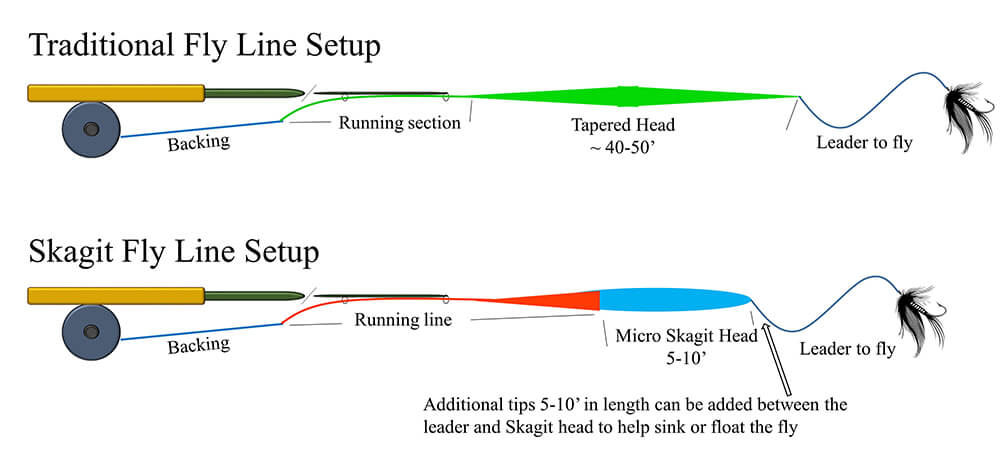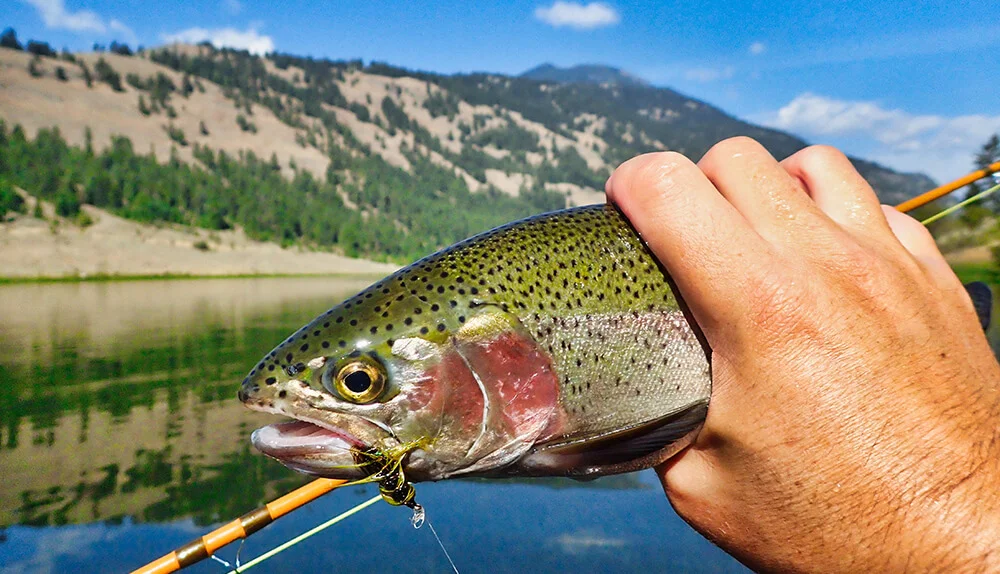Shooting Heads for Kayak Fly Fishing
By: Tyler Hicks
Developed in the mid-1800’s spey fly fishing has its origins in the salmon filled rivers of Scotland. Anglers needed a way to cast large salmon flies across wide rivers. Using 20’ plus long rods anglers could lift and shoot more than 50 yard shots of line across the river with precision. Fast forward a hundred years and advances in rod materials and designs as well as in fly line technology have allowed spey rods to shorten considerably. In the late 1990’s Pacific Northwest fly anglers were discovering just how effective large heavy flies fished on sink tips were at targeting Steelhead. Conventional spey lines at the time were simply too long, 50-60’, and lacked the ability to turn over these heavy setups. Anglers began building short heavy 20’ long heads that not only could turn over these heavy setups but required little room for backcasting, an advantage on the heavily forested rivers of the region. Thus the “Skagit head” was born; a simple compact spey system that made for effortless long casts of heavy and light flies with minimal need for backcasting space and false casting.
At this point you might be thinking, “What does this have to do with kayak fly fishing?” One of the greatest challenges I’ve faced as a kayak fly angler is line management and maximizing my casting distance. With conventional fly lines I struggled to double haul from a sitting position. Inevitably as I try to increase casting distance the fly or fly line would make contact with the water behind me and the cast would fall apart. Alternatively standing in the kayak would increase my drift speed in the wind, give way my location to spooky fish, line would get tangled in the pedal drive, and I still had to deal with countless flies stuck on the rear of my kayak seat or tangled in my tackle storage. Thus I was resigned to fishing relatively close to the kayak using short 30’ casts or trolling. That is until I discovered Skagit heads.
With the growing popularity of Skagit heads, fly line manufacturers responded by building an array of Skagit heads that have since been adapted and downsized to a variety of fisheries. Several fly line companies including Rio, Scientific Angler, and Olympic Peninsula Skagit Tactics have developed micro Skagit heads 5-10’ in length designed to be fished on single hands rods. Building a Skagit system is relatively easy. As with conventional fly fishing you will need to fill the reel with a suitable amount of backing, this is followed by about 100’ of running or shooting line with my favorite being Rio’s Gripshooter. Next the Skagit head is attached to the running line via a loop to loop connection. From there you can add a variety of tips that either sink or float or you can attach your leader directly to the end of the Skagit head, as I typically do, and start fishing. Many fly line companies now produced microspey lines that have integrated the running line and Skagit heads and come in both float and intermediate sink models.
The first time I cast a microspey setup I stripped out about 60’ of running line and with only a single backcast I shot all 60’ of line out and it still nearly ripped the rod out of my hand. I was instantly in love. Furthermore I could finally cast long distances, 60-80’, and throw big heavy flies from a sitting position with no false casting. This made for less arm fatigue and opened up opportunities to target larger game fish, like bass and pike, from the kayak on a fly rod without beating myself and my shoulder up.

I fly fish using this system from both my Sportsman BigWater 132 and my Sportsman PDL 120. I’ve found I can easily strip the running line down onto the deck. I keep the gear track uncluttered on the right hand side of the kayak from which I primarily fish. Casting is easy and comes natural especially for beginners. Strip out enough running line so that the Skagit head is just about 6” from the rod tip. I do a short poke cast in front of the kayak to layout the head and leader, then backcast, and then let her rip. No false casting is required and with a 9’ tapered leader you need only 20’ of space behind you to cast. With a little practice you can make pinpoint accurate casts of up to 80-100’ from a sitting position.
Whether you target trout, bass, pike, or even saltwater gamefish on the fly you can adapt any single hand fly rod and reel over to a compact Skagit head system. Work with your local fly shop to dial in the correct grain weight of the Skagit head. You’ll be amazed at the ease of casting, how much more water you can reach from a single point, and with this ability you’ll be spending more time fighting fish than chucking fluff through the air.